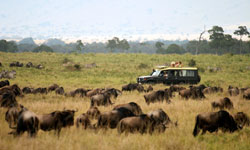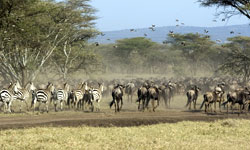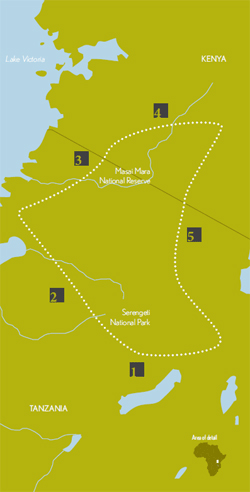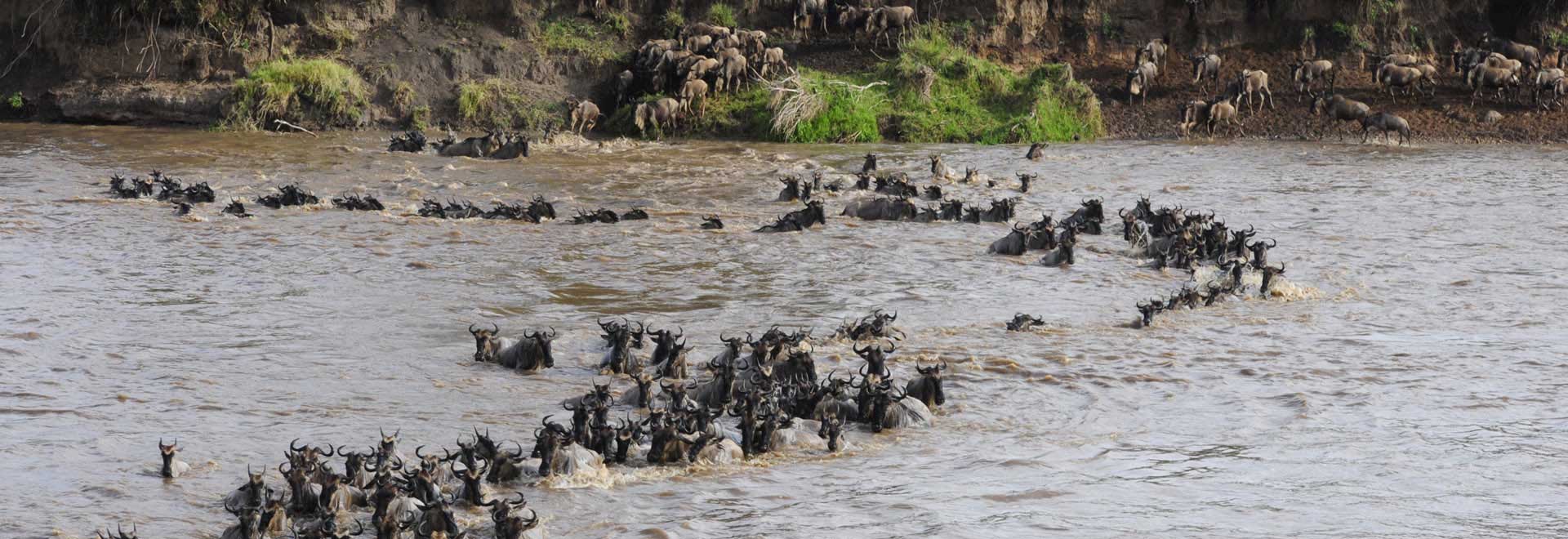The Great Migration
Some 1.4 million wildebeest, 250,000 Burchell’s zebra and a smattering of trailing Thomson’s gazelle make the yearlong, round-trip trek from Tanzania’s Serengeti to the Masai Mara in Kenya. The herds make the 1,200-mile oval circuit with two things in mind: food and water. “The smell of rain and sound of thunder spur the migration forward, but sometimes sideways and even back,” says David Bromham, senior Private Label Guide for A&K East Africa. Along the way, many migrating animals become prey to predators including lion, cheetah, crocodile and hyena.
In fact, around 250,000 wildebeest and 30,000 zebra perish in this tough trek, mainly younger ones. “Many times, mother wildebeest will just start running and keep running, not knowing that their young can’t keep up,” says David, an A&K Professional Safari Guide in Tanzania with 26 years of experience. That is one wildlife encounter to witness among many during a visit to East Africa, where the Great Migration’s mind-boggling scope and raw beauty are on full display throughout the year.
The Path of the Migration
1. January - March
The migration begins in the Serengeti. “Wildebeest tend to congregate in February, when they give birth to 300,000 calves,” David says. “The reason for concentrating in the south is to give their calves the richest milk, as the soil and grass is rich in potassium, calcium and phosphorus from the volcanic eruptions of two to three million years ago.” Joseph adds: “The southern part of the Serengeti has short grass, so wildebeest prefer to calve here, without fear of predators that typically lurk in taller grass.”2. April - May
“By April,” David says, “most of the grass is gone.” As the Serengeti starts to dry up, the herds follow the Grumeti River west.
3. June - July
“By June the Grumeti River is low, often leaving crocodile infested pools as the only water source in the area, and both wildebeest and zebra drink almost three gallons daily,” David says. “Come July, the main body is in and around Ikorongo and Fort Ikoma. At this time, the herds also hasten their approach to the Masai Mara as the reserve receives rain from Lake Victoria, about 70 miles away.”
4. August - September
The main mass reaches the Masai Mara, and the river crossings begin. “August is probably the best month to catch a crossing, but take a book and plenty of patience as it is a waiting game,” says David. “If you’re lucky, you may witness three or four high-drama crossings in one day. The feast-or-famine crocs lick their chops for four months of the year in total, though they can survive on fish and the fat in their tails for a year or more.”
5. October - December
The herds turn the corner and head back toward the Serengeti, as the rainy season starts in Tanzania. “By early October the Masai Mara grasslands are pool-table flat,” David says. “Now, the million-beast march starts the winding journey south, consuming approximately 5,000 tons of grass a day.”




 The Americas
The Americas
 Europe, Middle East and Africa
Europe, Middle East and Africa Australia, NZ and Asia
Australia, NZ and Asia